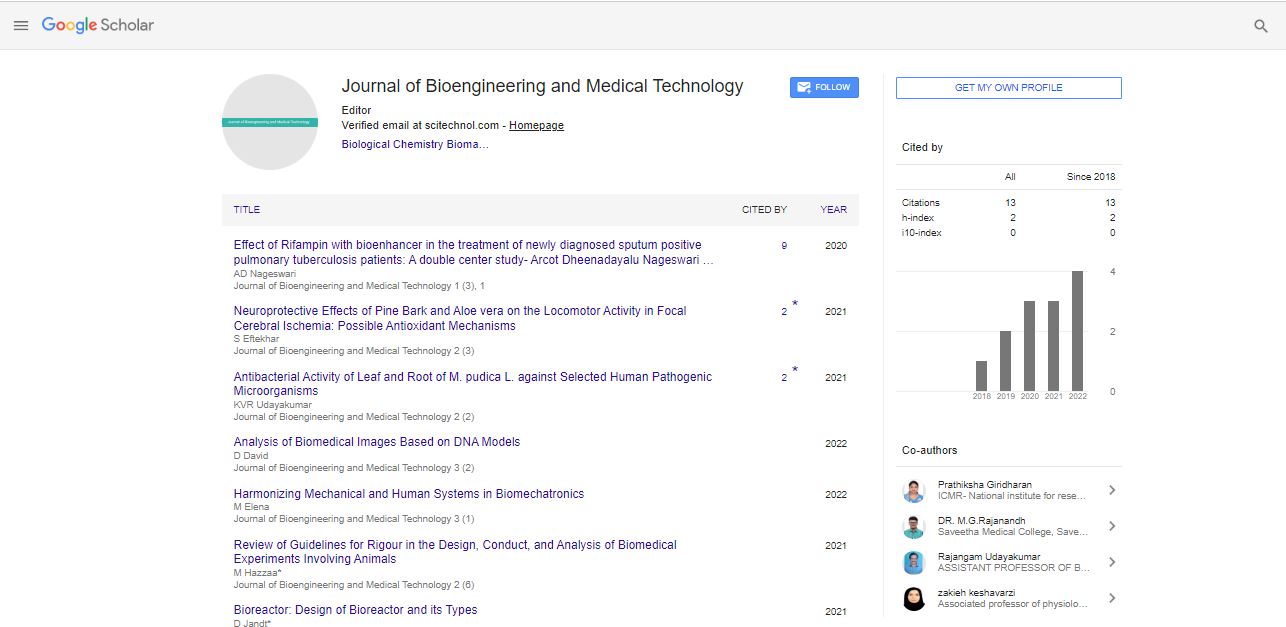Editorial, Jbmt Vol: 3 Issue: 1
Echotip Procore is a Brand-New Ultrasound Needle Available for Endobronchial Ultrasound
Zhong Lipeng *
Department of Chemistry, University of Aveiro, Aveiro, Portugal
*Corresponding Author:
Zhong Lipeng
Department of Chemistry, University of Aveiro, Aveiro, Portugal
E-mail:zhonglipeng@gmail.com
Received date: 03 January, 2022; Manuscript No. JBMT-22-57161;
Editor assigned date: 05 January, 2022; PreQC No. JBMT-22-57161(PQ);
Reviewed date: 17 January, 2022; QC No JBMT-22-57161;
Revised date: 27 January, 2022; Manuscript No. JBMT-22-57161(R);
Published date: 03 February, 2022; DOI: 10.4172/jbmt.100047.
Citation: Lipeng Z (2022) Echotip Procore is a Brand-New Ultrasound Needle Available for Endobronchial Ultrasound. JBMT 3:2.
Abstract
The use of real-time Endobronchial Ultrasound–Guided Trans Bronchial Needle Aspiration (EBUS-TBNA) for invasive mediastinal staging of Non–Small Cell Lung Cancer (NSCLC) is well-established. For mediastinal staging, needle-based approaches are currently suggested as a first-line diagnostic modality. A thorough understanding of mediastinal anatomy is required for accurate EBUS-TBNA systematic staging. Unless a higher station lymph node is positive for malignant cells by fast on-site cytology examination, this evaluation begins at the N3 lymph nodes and progresses through the N2 and N1 lymph node stations. Any lymph node station having a visible lymph node or a lymph node greater than 5 mm in short axis can be sampled objectively to identify EBUS-TBNA targets. Three passes per station are well-established approaches, as is the use of quick on-site cytology examination with detection of diagnostic material (tumors or lymphocytes) up to five passes. It's possible that more than three passes are required to obtain enough tissue for molecular profiling. EBUS-TBNA has similar operational characteristics to mediastinoscopy. In the case of a negative EBUS-TBNA and a high posterior likelihood of N2 or N3 involvement, mediastinoscopy should be considered.
Keywords: Endobronchial Ultrasound
Introduction
The use of real-time Endobronchial Ultrasoundâ??Guided Trans Bronchial Needle Aspiration (EBUS-TBNA) for invasive mediastinal staging of Nonâ??Small Cell Lung Cancer (NSCLC) is well-established. For mediastinal staging, needle-based approaches are currently suggested as a first-line diagnostic modality. A thorough understanding of mediastinal anatomy is required for accurate EBUS-TBNA systematic staging. Unless a higher station lymph node is positive for malignant cells by fast on-site cytology examination, this evaluation begins at the N3 lymph nodes and progresses through the N2 and N1 lymph node stations. Any lymph node station having a visible lymph node or a lymph node greater than 5 mm in short axis can be sampled objectively to identify EBUS-TBNA targets.
Three passes per station are well-established approaches, as is the use of quick on-site cytology examination with detection of diagnostic material (tumors or lymphocytes) up to five passes. It's possible that more than three passes are required to obtain enough tissue for molecular profiling. EBUS-TBNA has similar operational characteristics to mediastinoscopy. In the case of a negative EBUS-TBNA and a high posterior likelihood of N2 or N3 involvement, mediastinoscopy should be considered.
Endobronchial Ultrasound Needle
Over the last decade, the use of real-time Endobronchial Ultrasoundâ??Guided Trans Bronchial Needle Aspiration (EBUS-TBNA, also known as curvilinear probe EBUS-TBNA or linear EBUS-TBNA) has skyrocketed. EBUS-TBNA technology is presently in use in more than 85% of pulmonary and critical care programmers that participated in the survey [1]. As EBUS-TBNA systems have become more common, so have the technology's applications.
Invasive sample of mediastinal lymph nodes for Nonâ??Small Cell Lung Cancer (NSCLC) staging has been recommended by the American thoracic society, European respiratory society, European society of medical oncology, and American College of Chest Physicians (ACCP). The ACCP guidelines for lung cancer, third edition, recently suggested needle-based procedures as first-line approaches for invasive mediastinal staging of NSCLC [2]. The purpose of this study is to describe the methodology and procedures required to perform invasive mediastinal staging for NSCLC using EBUS-TBNA.
Increasing the stage of NSCLC is always associated with a significant drop in survival. It is critical to correctly stage NSCLC in order to ensure that patients receive the best treatment possible. The combined sensitivity of integrated Positron Emission Tomographyâ??Computed Tomography (PET-CT) for detecting NSCLC mediastinal spread is only 62%. Positive PET-CT findings must also be confirmed to ensure that a false-positive result does not rule out potentially curative treatment [3]. Despite these factors and guidelines for invasive mediastinal staging, mediastinoscopy has been underutilized in the past. More patients may be able to undergo appropriate invasive mediastinal staging now that EBUS-TBNA is widely available.
A thorough systematic evaluation of over 1,500 patients found no major EBUS-TBNA problems and only minor issues such as agitation, cough, and blood at the puncture site. Although problems such as mediastinitis, pericarditis, and mortality have been documented, prospective databases suggest that EBUS-TBNA complications occur at a rate of about 1%. Given EBUS-safety TBNA's record, improper pathologic staging may be the procedure's greatest risk. As a result, knowing the proper anatomic landmarks and lymph node stations is crucial [4]. This necessitates rigorous adherence to the revisions stated in the 7th edition lymph node map produced by the International association for the study of lung cancer and later released by the Union for International cancer control.
The thoroughness of mediastinal staging for needle-based procedures has been classified by Detterbeck and colleagues. Level A staging (full sampling) consists of sampling each visible lymph node in each station (1, 2R, 2L, 3, 4R, 4L, and 7) with at least three passes per node or rapid on-site cytology assessment. Malignant cells or lymphatic tissue must be reported if ROSE is used [5]. No study has analyzed the yield of complete mediastinal staging aspirating all EBUS-TBNAâ??accessible stations to our knowledge (including 3p).
Due to the presence of big mediastinal vessels on either side, Station 3A cannot be accessible via EBUS-TBNA. At stations 2R, 2L, 4R, 4L, and 7, Level B staging (systematic assessment) necessitates sampling nodes in each station using at least three passes per node or ROSE. If a left upper lobe tumor is present, sampling stations 5 and 6 are required for both comprehensive (Level A) and systematic (Level B) staging. EBUS-TBNA has limited access to these stations. The only known exception is station 5 aspiration through the pulmonary artery, which has only been done in extreme cases [6]. Station 5 has been aspirated inconsistently using endoscopic ultrasound-guided fine-needle aspiration.
Others have questioned whether the lymph nodes sampled in these studies are lateral to the ligamentum arteriosum. Invasive staging of stations 5 and 6 may necessitate a surgical technique or transthoracic needle aspiration. Level C staging (selected evaluation) is defined as aspiration of at least one aberrant lymph node (measured in centimeters by CT or ultrasonography) or fewer than three passes with no ROSE. To date, research has concentrated on either systematic (Level B) or selective (Level C) staging [7]. Further research may be needed to determine whether comprehensive (Level A) lymph node sampling in all accessible stations (including 1 and 3p) is superior to systematic (Level B) or selective (Level C) staging.
When compared to selected techniques, systematic surgical mediastinal staging has a higher accuracy, but the effect on overall survival is less obvious. There hasn't been a direct comparison of systematic and selective mediastinal staging with EBUS-TBNA [8]. Given the sensitivity limitations of CT and PET-CT, as well as the evidence from surgical techniques, systematic sampling of mediastinal lymph nodes through EBUS-TBNA may be preferable to selective sample. Selective staging of the mediastinum may be suitable in some cases. Further nodal sampling may be unnecessary if an enlarged N3 lymph node is aspirated with ROSE confirmation of malignant cells.
In the case of known M1 disease, a surgery conducted solely to gather tissue for diagnosis and/or genetic profiling would not necessitate a comprehensive staging evaluation. On the other hand, the appearance of a big core tumor on CT scan without enlarged lymph nodes is still linked with a high probability of N2 or N3 involvement, and meticulous staging is recommended [9]. Based on the radiographic appearance, a method for evaluating the pretest chance of mediastinal lymph node involvement has been adequately characterized. We focus on systematic approaches to invasive mediastinal staging in this study.
In many cases, EBUS-TBNA is used for both diagnosis and staging in the same procedure. To achieve these objectives, a wellâ??thoughtâ??out procedure plan is essential. The highest station lymph nodes are often sampled first during the staging assessment. This necessitates evaluating N3 level nodal stations first, then N2 level nodal stations, and ultimately N1 level nodal stations. Regardless of PET avidity, each nodal site should be considered for prospective needle aspiration [10]. Herth and colleagues looked examined the yield of EBUS-TBNA for mediastinal staging of NSCLC in patients who had no lymph nodes larger than 1 cm on CT and no aberrant tracer uptake on PET imaging. In 9 of 97 patients, sampling all lymph nodes more than 5 mm in the short axis revealed previously undetected cancer. Becker and colleagues found pathologic N2 illness in four of 102 individuals who had negative CT and PET tests. These findings are in line with previous reports of PET and PET-CT sensitivity, as well as the well-documented prevalence of "skip" metastases in NSCLC.
References
- Silvestri GA, Gould MK, Margolis ML, Tanoue LT, McCrory D, et al. (2007) American college of chest physicians non-invasive staging of non-small cell lung cancer: ACCP evidenced based clinical practice guidelines (2nd edition). Chest 132: 178-201. [Crossref] [Google Scholar] [Indexed]
- Antoch G, Stattaus J, Nemat AT, Marnitz S, Beyer T, et al. (2003) Non-small lung cancer: Dual modality PET/CT in preoperative staging. Radiology 229: 526-533. [Crossref] [Google Scholar] [Indexed]
- De Wever W, Ceyssens S, Mortelmans L, Stroobants S, Marchal G, et al. (2007) Additional value of PET-CT in the staging of lung cancer: Comparison with CT alone, PET alone and visual correlation of PET and CT. Eur Radiol 17: 23-32. [Crossref] [Google Scholar] [Indexed]
- Hiraki T, Mimura H, Gobara H, Iguchi T, Fujiwara H, et al. (2009) CT fluoroscopy guided biopsy of 1000 pulmonary lesions performed with 20-gauge coaxial cutting needles: Diagnostic yield and risk factors for diagnostic failure. Chest 136: 1612-1617. [Crossref] [Google Scholar] [Indexed]
- Herth F, Becker HD, Ernst A (2004) Conventional vs. endobronchial ultrasound-guided transbronchial needle aspiration: A randomized trial. Chest 125: 322-325. [Crossref] [Google Scholar] [Indexed]
- Khoo KL (2012) Mediastinal re-staging of non-small cell lung cancer. Thorac Cancer 3: 145-149. [Crossref] [Google Scholar]
- Medford AR, Agrawal S, Bennett JA (2009) Sarcoidosis: Technique to enable diagnosis. BMJ 339: 766-767. [Crossref] [Google Scholar] [Indexed]
- Garwood S, Judson MA, Silvestri G, Hoda R, Fraig M, et al. Endobronchial ultrasound for the diagnosis of pulmonary sarcoidosis. Chest 132: 1298-1304. [Crossref] [Google Scholar] [Indexed]
- Wong M, Yasufuku K, Nakajima T, Herth FJF, Sekine Y, et al. (2007) Endobronchial ultrasound: New insight for the diagnosis of sarcoidosis. Eur Respir J 29: 1182-1186. [Crossref] [Google Scholar]
- Kennedy MP, Jimenez CA, Bruzzi JF, Mhatre AD, Lei X, et al. (2008) Endobronchial ultrasound-guided transbronchial needle aspiration in the diagnosis of lymphoma. Thorax 63: 360-365. [Crossref] [Google Scholar] [Indexed]
 Spanish
Spanish  Chinese
Chinese  Russian
Russian  German
German  French
French  Japanese
Japanese  Portuguese
Portuguese  Hindi
Hindi 
